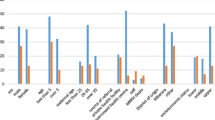Abstract
To analyse the patients with foreign body oesophagus in relation to the clinico-radiological and socio-economic profile. The present prospective study was conducted on 100 consecutive patients of all age groups who underwent oesophagoscopy for suspected foreign body ingestion in a tertiary care hospital. The most common age group affected was 0–5 years. The median age was 5 ± 14.37 years. There was preponderance in males as compared to females, male to female ratio was 2.23:1. Majority (70%) of the patients, both males and females, belonged to rural areas. Lower socio-economic group was more commonly affected (54%). The most commonly reported symptom was foreign body sensation (55%) followed by vomiting (54%) and difficulty in swallowing (51%). Foreign body ingestion was witnessed in only 19% cases by the family members. The mean time between ingestion of the foreign body and admission to the hospital was found to be 4.5 h. The majority (97%) of foreign bodies were radio-opaque. The most common site of lodgement was just below the cricopharynx (89%). The most common foreign body retrieved in our series were coins (65%). The majority of foreign bodies (68%) were retrieved in 20–40 min after induction of general anaesthesia. In 99% of the patients we did not encounter any complications. The majority (93%) of the patient’s parents/relatives had curiosity to have a glimpse of the foreign body till they actually saw the retrieved foreign body. Foreign body lodgement is more common among children of lower socio-economic strata more so in rural areas. Rigid oesophagoscopy is a safe and effective procedure for removal of the foreign body. Early intervention makes it easier to extract the foreign body without complications.



Similar content being viewed by others
References
Jackson C, Jackson CL (1936) Diseases of the air and food passages of foreign body origin. WB Saunders Company, Philadelphia
Song Kee LMW, Topazian M (2015) Gastrointestinal endoscopy. In: Kasper DL, Fauci AS, Hauser SL, Longo DL, Jameson JL, Loscalzo J (eds) Harrison’s principles of internal medicine, 19th edn. McGraw-Hill, NewYork, pp 1880–1900
Uyemura MC (2005) Foreign body ingestion in children. Am Fam Physicians 72:287–291
Singh RB, Dubey RK, Pandey V, Kumar V, Sharma SP, Annavi B (2014) Foreign bodies in digestive tract of children: a tertiary care hospital experience. Int J Med Public Health 4:463–466
Hamilton JK, Polter DE (1993) Gastrointestinal foreign bodies. In: Sliesenger MH, Fordtran JS (eds) Gastrointestinal disease: pathophysiology, diagnosis and management. W.B. Saunders Co., Philadelphia
Goel HC, Yadav SPS, Kohli GS, Singh J (1989) Oesophageal foreign bodies. Otolaryngology 18:49–52
Asif M, Haroon T, Khan Z, Muhammad R, Malik S, Khan F (2013) Foreign body oesophagus: types and site of impaction. Gomal J Med Sci 11:163–166
Rodríguez H, Passali GC, Gregori D, Chinski A, Tiscornia C, Botto H et al (2012) Management of foreign bodies in the airway and oesophagus. Int J Pediatr Otorhinolaryngol 76:84–91
Hjern A, Ringback-Wietoft G, Anderson R (2001) Socio-demographic risk factors for home-type injuries in Swedish infants and toddlers. Acta Paediatr 90:61–68
Sharma B, Raina S, Sharma N, Sharma R, Grover N, Sood A et al (2016) Endoscopic management of foreign bodies from the upper gastrointestinal tract in the hills of Himachal Pradesh, India: a 5-year tertiary care experience. J Dig Endosc 7:144–147
Louie JP, Alpern ER, Windreich RM (2005) Witnessed and unwitnessed esophageal foreign bodies in children. Pediatr Emerg Care 21:582–585
Singh G, Sharma S, Khurade S, Gooptu S (2014) Ingested foreign bodies in children: a report of two cases. J Fam Med Prim Care 3:452–455
Sinha S, Kumar S, Anshumita A (2016) Upper gastrointestinal tract foreign body in children in India. Int Surg J 3:2046–2049
Shivakumar AM, Naik AS, Prashanth KB, Hongal GF, Chaturvedy G (2006) Foreign bodies in upper digestive tract. Indian J Otolaryngol Head Neck Surg 58:63–68
Lin CH, Chen AC, Tsai JD, Wei SH, Hsueh KC, Lin WC (2007) Endoscopic removal of foreign bodies in children. Kaohsiung J Med Sci 23:447–452
Shinhar SY, Strabbing RJ, Madgy DN (2003) Esophagoscopy for removal of foreign bodies in the pediatric population. Int J Pediatr Otorhinolaryngol 67:977–979
Orji FT, Akpeh JO, Okolugbo NE (2012) Management of esophageal foreign bodies: experience in a developing country. World J Surg 36:1083–1088
Wai Pak M, Chung Lee W, Kwok Fung H, Van Hasselt CA (2001) A prospective study of foreign body ingestion in 311 children. Int J Paediatr Otorhinolaryngol 58:37–45
Luk WH, Fan WC, Chan RY, Chan SW, Tse KH, Chan JC (2009) Foreign body ingestion: comparison of diagnostic accuracy of computed tomography versus endoscopy. J Laryngol Otol 123:535–540
Plowman RS, Dance L, Barnes C, Jorgensen SA, Towbin AJ, Towbin R (2018) A radiolucent esophageal foreign body: diagnosis, management and potential complications. Appl Radiol 47:28–29
Biancari F, D’Andrea V, Paone R, Di Marco C, Savino G, Koivukangas V et al (2013) Current treatment and outcome of esophageal perforations in adults: systematic review and meta-analysis of 75 studies. World J Surg 37:1051–1059
Palta R, Sahota A, Bemarki A, Salama P, Simpson N, Laine L (2009) Foreign body ingestion: characteristics and outcomes in a lower socioeconomic population with predominantly intentional ingestion. Gastrointest Endosc 69:426–433
Acknowledgements
Dr. Savita Saini, Senior professor and head, Departmment of anaesthesiology, PGIMS, Rohtak, Haryana.
Author information
Authors and Affiliations
Contributions
VK: Manuscript review, Final Approval. SPSY: Manuscript review, Final Approval. RR: Definition of intellectual content, Manuscript editing. HM: Data acquisition, Definition of intellectual content, Manuscript editing. AM: Definition of intellectual content, Literature search.
Corresponding author
Ethics declarations
Conflict of interest
The authors declare “No conflict of interest”.
Informed Consent
Informed and written consent was taken at the time of surgery and before the submission of case report.
Additional information
Publisher's Note
Springer Nature remains neutral with regard to jurisdictional claims in published maps and institutional affiliations.
Rights and permissions
About this article
Cite this article
Kalra, V., Yadav, S.P.S., Ranga, R. et al. Epidemiological, Clinical and Radiological Profile of Patients with Foreign Body Oesophagus: A Prospective Study. Indian J Otolaryngol Head Neck Surg 74, 443–448 (2022). https://doi.org/10.1007/s12070-021-02553-5
Received:
Accepted:
Published:
Issue Date:
DOI: https://doi.org/10.1007/s12070-021-02553-5




